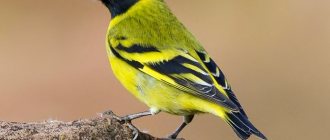Eagle bird: what it looks like and what it eats
Life expectancy depends solely on the type of eagle. The condor lives the longest, ranging from fifty-two to sixty-five years, and sometimes longer. The buffoon is the next species of eagles that lives about fifty-five years, the golden eagle from forty-six to fifty years, but there are also those that live longer. And the griffon eagle lives about thirty-eight
years .
The condor lives the longest - about 65 years.
The golden eagle lives up to 50 years.
Well, the griffon vulture lives up to 40 years.
A few words about other birds of prey. The condor, which is not an eagle at all but a vulture, can live up to 50 years in captivity. European vultures, such as the bearded vulture, are already closer to eagles - this bird is also of the hawk family and lives up to 40 years in captivity. The griffon vulture, also a relative of the hawk, feeds on carrion and can even live up to 40 years in natural conditions. Another representative of this family lives the same amount of time - the kite with a similar diet. But the kestrel, leading a more active lifestyle, barely lives to be 15 years old - the recorded maximum is 16 years.
Interesting facts about eagles
- If two chicks hatch in a nest, the stronger one will try to get rid of its brother or sister for 2 months. If he survives, then they begin to live peacefully side by side with each other.
- In antiquity, eagles were considered a symbol of victory and good luck, and in Egypt and China - a symbol of the sun.
- The eagle has long been considered a divine bird in many religions. Aztec rulers decorated their costumes with eagle feathers to bring themselves closer to the deities.
- The eagle is present on the coats of arms of many countries of the world, including Russia.
- After 40 years, the beak and talons of large eagles grow to such an extent that the birds practically lose the ability to eat and hunt. There are two options for the further development of events: the eagle either dies or breaks its beak on stones, pulls out its claws and old feathers, and after six months is reborn to live on.
Video
steppe eagle
The steppe eagle belongs to the hawk family of the genus eagles. The bird's population is insignificant and is steadily declining throughout its habitat. The feathered predator lives in steppe regions and semi-deserts. Birds of northern latitudes migrate south in winter. The inhabitants of the southern lands lead a sedentary lifestyle. Nesting areas cover the south of Western and Eastern Siberia, Central Asia, Central Asia, and western China. Nests are made in India, southern Africa and its central and eastern regions south of the Sahara.
Reproduction of eagles
Puberty of females and males occurs at the age of 4-6 years, even before the acquisition of adult feather “outfit”. Eagles choose their partner and remain faithful to each other for many years. The mating season depends on the degree of sedentism; in migratory species it lasts from mid-winter to April.
Mating games of eagles are characterized by spectacular aerial figures involving both members of the pair: chasing each other, undulating flight, sharp dives, spiral rotation.
The nesting territory is closely guarded from other predators, and the eagle’s nest itself is built high in the branches of trees, on rocky ledges and in niches. Sometimes eagles may choose geodetic towers and supports of high-voltage mains for nesting.
A pair of eagles can use the same nest for several seasons in a row, completing and renovating their home.
The clutch contains from 1 to 3 eggs, gray-white with dark spots. Laying occurs with a difference of 3-4 days.
Incubation of the clutch lasts 40-45 days, with the male sometimes replacing the female eagle.
Covered with grey-white fluff, eagle chicks hatch in the same order as the eggs are laid. The first cub has a better chance of survival by being aggressive towards its siblings. Parents are completely indifferent to this behavior of the first offspring.
The helpless chicks are fed by the female eagle, tearing the prey brought by the male into small pieces. At 65-80 days, the stronger chicks take wing and fly out of the nest, although in the first year of life they rarely leave the nesting territory.
Appearance
Males are smaller than females. The usual body length of a bird ranges from 60 to 80 cm. The wingspan reaches 160-190 cm. Weight is 1.6-3.2 kg. The plumage color is reddish-brown. There is often a red spot on the back of the head. The tail feathers are dark brown. Transverse gray stripes clearly appear on them. The beak is grayish-black, the claws on the paws are black. Limbs yellow. The plumage of young birds under 4 years of age is lighter than that of mature relatives.
The color of the feathered predator allows it to camouflage well while hunting on the ground. It should be noted that the color of the plumage changes depending on the seasons. In females, during nesting, the color acquires darker shades. While flying over the endless steppe, the steppe eagle spreads its wings like fingers. Thanks to this, the bird can soar above the ground for a long time. The tail is long and rounded. It is shaped like a wedge.
Description of eagles
The history of the majestic bird of prey goes back to ancient times, but in the cultural heritage of most peoples of the world, the eagle even today personifies glory and luck, victory and power. Most of the eagle species known today are characterized by impressive sizes, and the body length of some adult individuals may well be 80-95 cm . At the same time, female eagles are noticeably larger than males. The body weight of an eagle often varies between 3-7 kg. The exceptions are the smallest species: the dwarf eagle and the steppe eagle.
Appearance
Representatives of the genus are distinguished by a massive body with a fairly developed muscle layer and relatively long, strong legs, feathered right down to the toes. The head region of eagles is compact, with a strong and muscular neck. Large eyeballs are characterized by slight mobility, but the well-developed neck area more than compensates for such a minor deficiency.
One of the main differences between eagles is their impressively sized claws, as well as a very strong beak with a curved end, which gives such a bird unsurpassed predatory qualities. The talons and beak of an eagle grow throughout the life of the predator, but the vital activity of birds contributes to their fairly active grinding. All representatives of the Hawk family and the Eagle genus have long and relatively wide wings, the maximum span of which reaches 250 cm, which allows the bird of prey to soar for a long time at an altitude of more than 600-700 meters.
This is interesting! Even with fairly strong wind gusts, eagles are able to cope with any air currents, so they can easily dive onto spotted potential prey at a speed of 300-320 km/h.
Among other things, eagles by nature have extremely acute vision, thanks to which birds of prey are able to look out from a very great height for even the smallest prey, which is most often represented by lizards, snakes and mice, and peripheral vision helps the bird to easily view areas of up to 12 m2. Hearing is used by adult eagles, mainly for the purpose of communication, and the bird’s sense of smell is poorly developed.
The color of the main plumage of an eagle varies depending on the species, so it may well be completely monochromatic or have contrast and specks. The flight of an eagle of any species is distinguished by special indicators of maneuverability, accompanied by deep and powerful flapping of its wings.
Reproduction and lifespan
A male and female pair are created for life. The nest is made on rocks, trees, low bushes, and the ground. Eggs are laid from mid-April to mid-May. There are usually 2 eggs in a clutch, sometimes 1 or 3. Their color is white and diluted with brown specks. The incubation period lasts one and a half months. The entire nesting process lasts about 3 months. It ends after the young birds take wing. The life expectancy of this predator in favorable conditions reaches 40-45 years.
Reproduction
Most breeds reach sexual maturity quite late by bird standards. They are ready to breed at the age of 4-5 years.
When they build nests
Mating games for most eagles take place in April; having split into pairs, the birds begin building nests. Eagles make very large structures using dry branches, leaves, moss, antelope skins, cardboard and even bones.
The size of eagle nests is amazing
Mating, who hatches the eggs
Eagles mate for life; some species of birds will look for a new partner only after the death of the old one, while others will remain lonely in this case. The female most often does the incubation, although males help her from time to time. The main tasks of the “men” are hunting and providing the “family” with food.
Chicks
Note! One of the reasons for the rarity of birds is that there are only 1-2 chicks in a nest, and they are born at different times. Because of this, the older baby often destroys the younger one in the fight for food.
Less commonly, there may be 3 eggs in captivity.
What do the chicks feed?
Males get their usual food: rodents, reptiles, small birds - and all this is used to feed the chicks. In general, the meat of caught animals is what the eagle eats, starting from early childhood.
Behavior and nutrition
The feathered predator hunts mainly small animals. These are mice, voles, hamsters, gophers. Such preferences have a positive effect on agriculture, because rodents that harm crops are destroyed. The steppe eagle's area of interest also includes hares, lizards, snakes and birds. While hunting, the predator can run on the ground. At the same time, he jumps slightly and flaps his wings.
Victims are observed mainly from the air while hovering above the ground. In some cases, the steppe eagle watches for rodents near the hole. He can not only sit, but also lie down, patiently waiting for the same gopher to poke his head out of his shelter. The bird runs superbly on the ground and easily catches up with its prey. The predator also uses man-made creations for hunting. He can sit on the same telegraph pole and closely inspect the immediate surroundings. These birds are silent. Very rarely they emit abrupt, hoarse cries somewhat reminiscent of a crow's caw.
What is the difference between an eagle and a bald eagle?
Despite belonging to the same hawk family, the eagle and sea eagle differ, mainly in their lifestyle. The eagle inhabits mountainous, desert and wooded areas; the eagle chooses the banks of water bodies for nesting, because it usually feeds on fish, animals and birds that live near water. As for the external differences between an eagle and a sea eagle, they also exist:
- the paws of eagles are very densely feathered, but the paws of the eagle in their lower part are devoid of such “chic” plumage;
- the eagle's beak is more powerful and somewhat larger than that of an eagle;
- The eagle's tail is wedge-shaped, and the eagle's tail is quite narrow and short.
The situation with the abundance of the species
In order to exist normally, the bird needs lands where there is no place for human activity. However, vast expanses of steppe are now being converted into arable land. This directly affects the population size. The extermination of rodents also affects the number of bird predators. Various chemicals used by people to preserve crops also have a harmful effect on the body of birds. If everything remains as it is, then the steppe eagle will very soon disappear from the face of the earth. Currently, this species is listed in the Red Book and is protected by law.
Return to article: Snowy owl
♦ ♦ ♦
There are several different species of eagles. In most cases, these birds are inhabitants of the temperate and subtropical zones of Eurasia. Eagles can be found from Scotland to Mongolia, Kazakhstan and India. The wedge-tailed variety of birds lives in Australia. Crested and crested eagles are found throughout Africa. The most common species is the steppe eagle, which inhabits the territory of the Czech Republic, Slovakia, Ukraine, Spain, and Turkey.
Eagles
From time immemorial, eagles have been considered the kings of the kingdom of birds; they have acquired the status of the strongest, bravest and noblest inhabitants of the skies. The world fauna includes about four dozen species of these birds, divided into several genera in the Yastrebin family. Among birds of prey, their closest relatives are eagles, harpies and buzzards.
Hawk eagle (Aquila fasciata).
All eagles are medium to large sized birds. Only the smallest species - the steppe eagle and the dwarf eagle - weigh 1.6-2 and 0.5-1 kg, respectively, while the mass of other species is 3-5 kg, the wingspan reaches 2 m, with females 25 -30% larger than males. When looking at an eagle, one notices a powerful hooked beak, a well-developed neck, huge wings that even when folded extend beyond the chest line, and relatively long legs with strong fingers and curved claws. All this exposes them as dexterous predators, obtaining food exclusively by active hunting and not begging for carrion.
Kaffir eagle (Aquila verreauxii).
Based on the type of coloration, all eagles can be divided into two groups. Most species are uniformly colored brown, black, or reddish with individual streaks on the wings. Some species (hawk, martial, crowned eagles) have a contrasting color - the top and head are dark, the bottom is light. Their abdomen and wings are dotted with specks or stripes. In addition, African crested and crested eagles have a tuft of long feathers on their heads.
Crested eagle (Lophaetus occipitalis).
Species from the genus of true eagles inhabit predominantly the temperate and subtropical zones of Eurasia - from Scotland in the northwest to Kazakhstan, Mongolia and India in the southeast. The wedge-tailed eagle lives in Australia, on the islands of Tasmania and New Guinea. All these birds prefer to settle in open landscapes: in steppes, semi-deserts and mountains bordering treeless plains. Crested, crowned, and crested eagles live in Africa and prefer sparse forests and shrubby savannas.
Steppe eagle (Aquila rapax) on the nest.
Eagles live in sedentary pairs and most often hunt alone. In search of prey, they soar for hours at great heights like vultures or condors, although they are inferior in size to the latter. But the lightness and grace of eagles are deceptive; at the right moment they quickly descend, stretch their paws forward and grab the prey, stunning it with a blow of their beak. Strong wings allow them to easily maneuver near the surface of the earth and the edges of steep cliffs, so it is very difficult for a potential victim to escape from a feathered predator. In addition to maneuverability, the exorbitant strength of these birds attracts attention. Unlike other birds of prey, eagles often attack animals much heavier than themselves: foxes, wolves, roe deer, gazelles, antelopes. And catching hares, marmots, gophers, small monkeys and birds is not at all difficult for them.
The foot of a crowned eagle (Stephanoaetus coronatus) compared to a human hand. The huge claws act like needle-nose pliers, simultaneously squeezing and piercing the victim's body.
Eagles usually eat caught prey on the spot; they only take food for the chicks to the nest. If several birds attacked the victim together, then when it is eaten, fights often occur. After a meal, the birds drink a lot and carefully clean their plumage. If an eagle fails to catch a sufficiently large prey for a long time, it may descend to feeding on carrion or catching insects.
A steppe eagle stuffs its crop with the meat of a killed gazelle.
The voice of these birds sounds thin and shrill. Most often they make calls like “kli-kli-kli”, less often - dull sounds. Eagles are intolerant of their neighbors and, when they see a competitor, they start a fight with him while still in the air. Huge birds intimidate each other, imitating an attack, and if this does not help, they lock their claws and circle in free fall. The male and female perform a similar dance during the mating season.
A martial eagle (Polemaetus bellicosus) attacks a warthog.
Eagles breed once a year; in the southern regions they lay eggs in winter, in the northern regions - in the first half of spring. Birds place their nests on the tops of tall trees, rock ledges, and less often on the ground. Eagles often seize old nests of crows, falcons, and hawks and build them to the required height. The couple uses the nest for many years in a row, annually adding fresh green branches to it. Over time, it takes on the appearance of a huge heap.
Young steppe eagle chicks. It is noticeable that when building the nest, the birds used scraps of plastic bags - a tribute to modern civilization to nature.
There are most often 2 (less often 1 or 3) eggs in a clutch. Incubation in different species lasts 35-45 days. The care of the clutch falls entirely on the shoulders of the female, while the male brings her food at this time. The mother continues to warm the chicks for some time after hatching, and later begins to go hunting. Parents show unusual tenderness for such bloodthirsty birds, which cannot be said about the babies: from the first days of life they begin to quarrel over prey, and the older one often pecks at the younger one, and then eats him. After rising to the wing, the chick begins to hunt on its own, but for some time it still uses parental feeding. Young eagles roam until they have a mate. They reach sexual maturity by 4-5 years, and remain faithful to their partner until death. Their life expectancy is also one of the highest in the world of birds; large eagles often live up to 40-50 years.
The same eaglets, but they have already begun to fledge.
Despite their strength, eagles remain rather vulnerable links in the ecological chain. In nature, they have few enemies - adult birds can only die in a fight with a rival or a wolf. Hunger is much more dangerous for them. The constant need for large prey forces eagles from the temperate zone to migrate south following other migratory birds. But as new areas of virgin land open up and wild animals disappear, the usual food sources become insufficient. In addition, eagles, unlike other birds, often die on power lines while trying to build a nest on a pole. Currently, almost all Eurasian species are quite rare, and the imperial eagle, dwarf eagle, and steppe eagle are listed in the national Red Data Books of a number of countries.
Read about the animals mentioned in this article: eagles, vultures, condors, foxes, wolves, marmots, hares, warthog.
Eagle Habitat
The habitat of a given species of bird is also determined by the individual characteristics of the species. The steppe eagle is a regular in the steppe and semi-steppe zones. Eagles can also live in dense forests or open coastal areas. The close proximity of rivers, lakes and swamps attracts this bird. Some species of eagles can live freely in the desert or build their nests high in the mountains.
What is the difference between an eagle and a hawk?
- The most important difference between an eagle and a hawk is size: a hawk is much smaller than an eagle.
- The wings of a hawk are short, slightly rounded and slightly bent, while the wings of an eagle are long, wide, and have a span of up to two and a half meters.
- The eagle's tail is shortened, but the hawk's tail is long.
- Another difference between these birds is the type of flight: the eagle soars for a long time, hovering in air currents, while soaring flight is not typical for the hawk.
Are eagles dangerous to humans?
An adult eagle has everything it takes to cause significant harm to human health. It cannot be said that attacks are regular, but there were times when a person became the target of an eagle attack. For example, a crowned eagle that lives in the tropical forests of Africa once attacked a small child and tried to drag him away. The bird's attack was repulsed simply because the eagle was unable to lift its potential victim into the air.
News and society
Threat to Eagles
These birds pay for their beauty and majesty with their lives. They were exterminated and continue to be exterminated, either for the sake of making stuffed animals, or because of false accusations of a threat to livestock, game animals and fish.
The widespread use of aggressive chemicals in agriculture also threatens bird numbers.
The shaken natural balance periodically threatens the eagles with starvation due to lack of food.
Like all living beings, eagles - these graceful animals of unearthly beauty - deserve that humanity is concerned with the problem of the real possibility of their extinction and prevents this from happening.
How long does an eagle live compared to other long-lived birds?
Everyone knows that many birds live relatively long lives. And some of the species set unique longevity records. Thus, the turkey vulture, a scavenger bird, can survive up to 118 years (of course, if it does not collide with airplanes, because birds of this species fly high into the sky, and accidents often occur).
And an ordinary raven can live up to a hundred years or more (according to unverified data, the most ancient ravens reached the 200-year mark). In the mythology of some peoples, it is generally considered eternal, but this is far from the case. After all, everything living on earth has its own life span. Bird observations are usually made in captivity. But by the way, it was noticed that in such conditions crows live much longer than in the wild.
Another eternal companion of humanity is parrots. There are whole legends about their life expectancy. This is largely because some parrots outlive their owners and move on to others. So it seems that this bird lives forever. In fact, some species of large parrots can live up to 80 years, no more.
Next on the pedestal of avian longevity are hawks: golden eagles and sea eagles. How long do eagles live? Their lifespan also sometimes reaches 80 years. In American Indian culture, both the bald eagle and the golden eagle are traditionally considered God's messengers and sacred birds. Their feathers and claws, and other parts of the body are used for ritual rites and ceremonies. In terms of their impact and sacred meaning, such signs can be comparable, for example, to a Christian crucifix. And successful warriors and hunters received these feathers from the elders and the leader as insignia.
general information
Today there are more than 15 species of eagles, distributed throughout Africa, Eurasia and North America. These are birds of prey. The food preferences of these birds depend on the conditions and location of their habitat.
These are quite large birds, the smallest of which is the size of a raven. The largest eagle is the golden eagle. It is valued as an excellent bird of prey, capable of catching a fox, a hare, and even a small ungulate.
Although it is difficult, the golden eagle can be trained, and it is worth it. Hunting with him is very exciting and exciting. It should be noted that the cost of a trained falcon is comparable to the price of a good off-road jeep.
Before we find out how long an eagle lives, let us present the general characteristics of the bird of prey and some interesting facts related to it.
Today there are more than 15 species of eagles, distributed throughout Africa, Eurasia and North America. These are birds of prey. The food preferences of these birds depend on the conditions and location of their habitat.
These are quite large birds, the smallest of which is the size of a raven. The largest eagle is the golden eagle. It is valued as an excellent bird of prey, capable of catching a fox, a hare, and even a small ungulate.
We suggest you read: How many years do sea turtles live?
Before we find out how long an eagle lives, let us present the general characteristics of the bird of prey and some interesting facts related to it.
In the wild, in the wild
Research scientists have discovered that eagles live less time in the wild than, for example, in zoos. On average, the total species lifespan of eagles ranges from 30-70 years. It is difficult to give more accurate data due to the fact that some species of eagles live in rather inaccessible places where humans rarely set foot, which makes study difficult. In addition, some species of hawks are on the verge of extinction.
steppe eagle
From Masterweb
How long does this type of predator live? First, let's present a short story about this bird.
About 30 years ago, the steppe eagle was the most numerous species among these predators in Northern Eurasia. Today, the number and area of its distribution have sharply decreased. The population of the species worldwide does not exceed 60 thousand pairs, and only up to 3.5 thousand pairs nest in Russian territories. They are included in the Red Book of Russia.
Such changes are directly related to human activity: severe depletion of the food supply due to the active use of pesticides in agriculture, human development of the steppes, destruction of nests and shooting of birds. It has also been established that the steppe eagle suffers more than its other relatives from electric lines, since in the absence of trees in the steppe area, it uses poles instead of hunting perches and dies from the effects of current.
The steppe eagle is widespread in the semi-desert and steppe zones of Northern Eurasia. These are the territories of Russia, China, Mongolia and Kazakhstan. The largest population lives in Kazakhstan (up to 50 thousand pairs).
How many years do steppe eagles live? Their average life expectancy is relatively long. In captivity, they often live up to almost 50 years, and in nature - less, although there is no exact data on this.
How long does this type of predator live? First, let's present a short story about this bird.
We invite you to read: Neons - care and maintenance of fish at home
About 30 years ago, the steppe eagle was the most numerous species among these predators in Northern Eurasia. Today, the number and area of its distribution have sharply decreased. The population of the species worldwide does not exceed 60 thousand pairs, and only up to 3.5 thousand pairs nest in Russian territories. They are included in the Red Book of Russia.
The steppe eagle is widespread in the semi-desert and steppe zones of Northern Eurasia. These are the territories of Russia, China, Mongolia and Kazakhstan. The largest population lives in Kazakhstan (up to 50 thousand pairs).
How many years do steppe eagles live? Their average life expectancy is relatively long. In captivity, they often live up to almost 50 years, and in nature - less, although there is no exact data on this.
Eagle in world symbolism
Due to their fairly respectable life expectancy, these birds of various species have occupied an important place in the symbolism of many peoples, as if reminding us of how long the eagle lives - a strong and beautiful bird. So in Europe in the Middle Ages, eagles began to appear on many family coats of arms of nobles and nobles, symbolizing strength and immortality in a heraldic context. And among modern states, Mexico has an image of a golden eagle on its flag and coat of arms. This same bird is officially considered the national symbol of the country. And on the flag of Kazakhstan there is an image of a golden eagle, which occupies a special place in the world description of nomads, and its imprints on the flags of many nationalities inhabiting Asia have long traditions.
Comments
Similar materials
Home and family How long does an egg live after ovulation or why is it so difficult to get pregnant?
If a woman decides to get pregnant, but cannot do it right away, then she has a lot of questions, fears and doubts. However, the most important thing is not to worry in vain. Statistics say that a healthy woman...
Business How long does a bee live, and what does its life expectancy depend on?
Bees live in large families - swarms, each in its own hive. The family includes...
Business How long does a decorative rabbit live?
When deciding to get a pet, future owners quite rightly begin to collect all the information available about it. The question of how long a rabbit lives can be far from idle, especially if...
Home and family How long does a Rottweiler live: average standards, features and reviews
There is not a person in the world who has not heard of the Rottweiler. This massive dog breed often terrifies people with its powerful body and toothy mouth. The owner of such a dog can be confident in his safety...
Home and family Features of the structure of paws, or How many toes do dogs have
For many people, a dog is an equal member of the family that requires care and attention. Once upon a time they were faced with a choice: to have a four-legged friend or not. With the advent of a small pet, all doubts disappear.
Home and family Domestic rat: reviews, maintenance, care, feeding, breeding. How long does a rat live at home?
Animal lovers have very different preferences: some love cats, others prefer smart and loyal dogs, while others can spend hours watching the life of underwater inhabitants. And for some there is no better pet than...
Home and family What does a British cat look like and how long does it live?
Those who have seen a British cat at least once become true admirers of these graceful animals endowed with aristocratic habits. Representatives of this breed are distinguished by excellent health and externally resemble…
Home and family How long does a French bulldog live? Disadvantages of the breed
Having settled a tiny defenseless creature in an apartment, people begin to think about how long their four-legged friend can be with them. And the more time passes, the more attached we become to our...
Home and family Chilean degu squirrel: care, food, keeping at home. How long does a degu squirrel live?
Degu - Chilean squirrel (lat. Octodon degus) is a rodent from the genus of eight-toothed. The homeland of this animal is the foothills of the Andes of Peru and Chile. Locals call the degu a bush rat. And recently...
Home and family How long does a chinchilla live at home and what are the basic rules for caring for it?
Chinchilla - who is this? The question is quite logical, because we know such a small pet - a rodent. Some cat breeds also have this coat color. They are magnificent, for example the golden chinchilla...
What is the difference between an eagle and a kite?
- The kite has a short, hooked, but rather weak beak, while the eagle has a very powerful and durable beak.
- Like the eagle, the kite can soar in the sky easily and for a long time, but you can immediately distinguish these birds by their flight. The kite has seemingly excessively long wings and an equally long fork-shaped tail. The eagle is much larger in size, its wings are wide, with feathers spread along the edges and ends, and the tail is shorter than that of a kite.
- Eagles are excellent hunters with excellent vision, maneuverable and swift when attacking. Kites are somewhat phlegmatic and lazy: they are not distinguished by agility and speed, they often feed on what they take from already caught prey from other birds, not disdaining carrion.
- For nesting, the kite chooses tall, often solitary trees. There are frequent cases when a kite occupies other people's nests. The eagle builds nests in forests and on steep cliffs, as well as on the surface of the earth.
Types of eagles, names and photos
The hawk family includes 70 genera, which contain 14 subfamilies, but among them there are hawks, eagles, kites, vultures, and buzzards. The modern classification includes 17 main species of eagles, each with its own distinctive characteristics. Here are some of them:
- Golden eagle (Aquila chrysaetos)
The largest eagle in the world, the weight of individual individuals can reach almost 7 kg. Body length 76-93 cm, wingspan 1.8 - 2.34 meters. A distinctive feature of the species is the rear edge of the wings, curved when soaring in the shape of the Latin letter “S”. Young golden eagles are distinguished by their almost black feathers with white “signal” spots on the wings, which is a typical defense against aggression of the older generation.
Golden eagles are common in the western part of the North American continent, in Central Mexico, Africa, Asia, in the mountainous regions of European territory, and on the islands of the Mediterranean. In Russia they are found everywhere from the Amur region to Kamchatka.
- Hawk eagle (Aquila fasciata, formerly Hieraaetus fasciatus)
It is distinguished by its black-brown back plumage and white belly with dark transverse stripes. The eagle's weight is about 2.5 kg. The length of the wings is 46-55 cm, the length of the eagle’s body is from 65 to 75 cm.
Obi's range











